To upgrade your apartment Wi-Fi for smart home reliability, start by evaluating your current setup and building infrastructure to choose the best internet service, like fiber or cable. Place your router centrally and elevated to maximize coverage, and consider upgrading to a mesh system with wired backhaul for seamless connectivity. Secure your network and manage device connections to avoid slowdowns. If you’re curious about optimizing every aspect, there’s more to explore below.
Key Takeaways
- Evaluate building wiring and infrastructure to determine feasible internet options like fiber, cable, or fixed wireless.
- Optimize router placement by positioning it centrally, elevated, and away from interference sources for better coverage.
- Upgrade to a high-performance router with advanced features to support multiple smart devices reliably.
- Secure your Wi-Fi with strong passwords, separate guest networks, and regular firmware updates to protect data.
- Consider implementing mesh networks with wired backhaul and additional nodes to ensure seamless coverage and future growth.
Assessing Your Current Internet Setup and Building Limitations
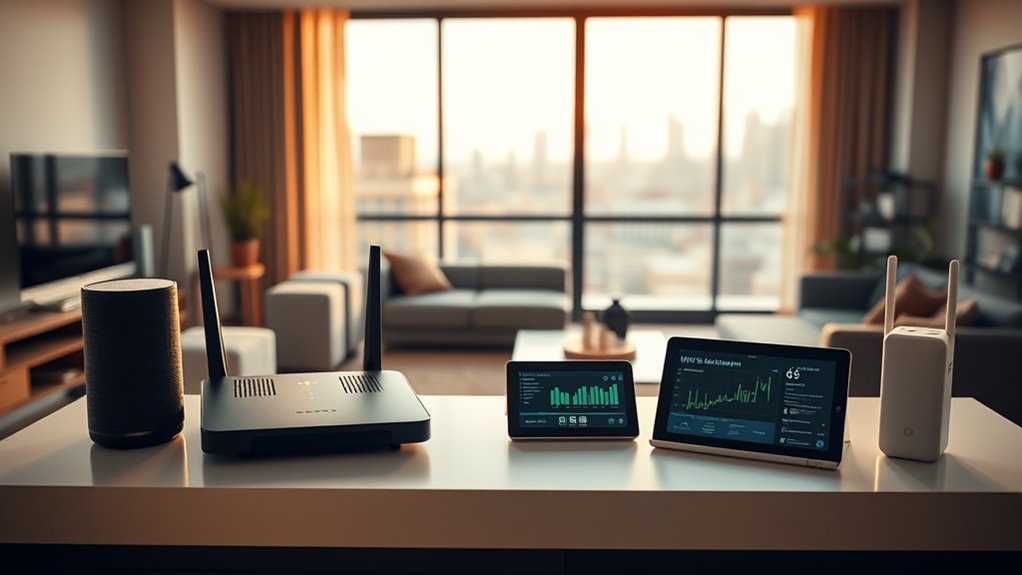
Before upgrading your apartment Wi-Fi, you need to evaluate your current internet setup and understand your building’s limitations. Check with your leasing office or property owner to identify available internet options and any restrictions related to building wiring.
Many buildings support only one type of service, like cable or fiber, which can limit your choices. Upgrading or adding new wiring, such as fiber optic cables, often requires landlord approval and might involve construction work like drilling or mounting equipment. Cost considerations can also influence the feasibility of such upgrades, as wiring and installation costs vary widely. Additionally, understanding the building infrastructure can help you determine what upgrades are possible without extensive modifications. Recognizing the limitations of building wiring can help you choose the most effective and feasible upgrade options for your situation. Furthermore, assessing the existing network hardware in your apartment can reveal potential bottlenecks that may need extra attention during upgrades.
Keep in mind that bulk billing arrangements between landlords and providers are common but don’t guarantee exclusive access, so your options could be limited. Satellite internet usually isn’t permitted in apartments, ruling out satellite dishes.
Understanding these factors helps you plan a successful upgrade. Recognizing how creative practice can foster problem-solving skills may also aid in navigating technical challenges during the upgrade process.
Choosing the Right Internet Service for Your Apartment

Choosing the right internet service for your apartment depends on your location and the available options. Start by considering your building’s wiring and what your Internet Service Provider (ISP) offers. Juice Packaging and Storage can be relevant here when thinking about ensuring a stable power source for your networking equipment, especially if you experience outages. Additionally, evaluating network reliability and latency can help you choose a service that maintains consistent performance for your smart home devices.
Selecting the best internet service depends on your location and building infrastructure.
Here are your main choices:
- Cable internet, common in urban apartments, provides high speeds at competitive rates.
- Fiber-optic internet offers faster, more reliable connections with better upload speeds but may have limited coverage. Being aware of allergy risks associated with certain materials used in wiring and infrastructure can be helpful.
- Fixed wireless internet, like Starry, uses a receiver on your building and can be ideal if infrastructure supports it.
- Satellite internet is generally unavailable in apartments due to dish restrictions.
Your router will connect to your chosen ISP’s service, creating a Wi-Fi network. Confirm the options supported by your building before making your decision for a reliable smart home setup.
Optimizing Router Placement and Wi-Fi Coverage

Placing your router in a central spot helps guarantee even Wi-Fi coverage throughout your apartment. Elevating it on a high, open surface reduces interference from walls and furniture, boosting signal strength. Using performance metrics to monitor your network can help identify areas needing improved coverage. Regularly testing your signal and adjusting the router’s position can eliminate dead zones and improve overall performance.
Central Placement Matters
Positioning your router in the center of your apartment is key to maximizing Wi-Fi coverage. Proper router placement guarantees your Wi-Fi signal reaches every corner without dead zones. Using signal mapping apps can help you identify weak spots and improve your network performance. Here are four tips to optimize coverage:
- Place your router high on a shelf or mount it on the wall to reduce interference. Regularly assessing your space and adjusting your setup can enhance overall coverage and prevent clutter from blocking signals. Additionally, choosing a location away from electronic interference sources can significantly improve signal strength. Understanding Wi-Fi interference helps in selecting optimal placement. Incorporating antenna orientation adjustments can further strengthen your signal distribution.
- Keep it away from electronic devices like microwaves and cordless phones that can disrupt the signal.
- Avoid placing it near entry points or in corners where coverage can be limited.
- Use Wi-Fi signal mapping apps to identify weak spots and adjust your router’s position accordingly. Incorporating vertical storage solutions to elevate your router can be an effective way to improve signal distribution.
Elevate for Better Signal
Elevating your router to a high, open location can markedly boost your Wi-Fi signal. When you elevate your router, it reduces interference from walls, furniture, and appliances, improving signal strength. Placing it centrally in your apartment, ideally around 1,200 sq ft, ensures more uniform Wi-Fi coverage. Keep your router away from large furniture and metal objects to prevent signal degradation. If some areas still have weak signals, consider repositioning your router or adding mesh nodes strategically. Use Wi-Fi analysis apps to identify dead zones and optimize placement. Here’s a quick guide:
| Placement Tip | Effect | Ideal Location |
|---|---|---|
| Elevate your router | Boosts signal strength | High, unobstructed shelf or mount |
| Central positioning | Improves coverage | Apartment’s core area |
| Minimize barriers | Reduces dead zones | Away from walls and metal objects |
Additionally, understanding angel number soulmate concepts can help you recognize the importance of harmony and balance in your Wi-Fi setup, paralleling how spiritual connections thrive in balanced relationships. Proper placement not only enhances performance but also ensures a more reliable connection, which is essential for smart home devices to function seamlessly. Employing modern routers with noise reduction technology can further minimize interference and optimize your Wi-Fi experience. Being aware of network security best practices can also safeguard your connection from potential threats, ensuring consistent and safe smart home operation.
Replacing Faulty Devices and Upgrading Equipment
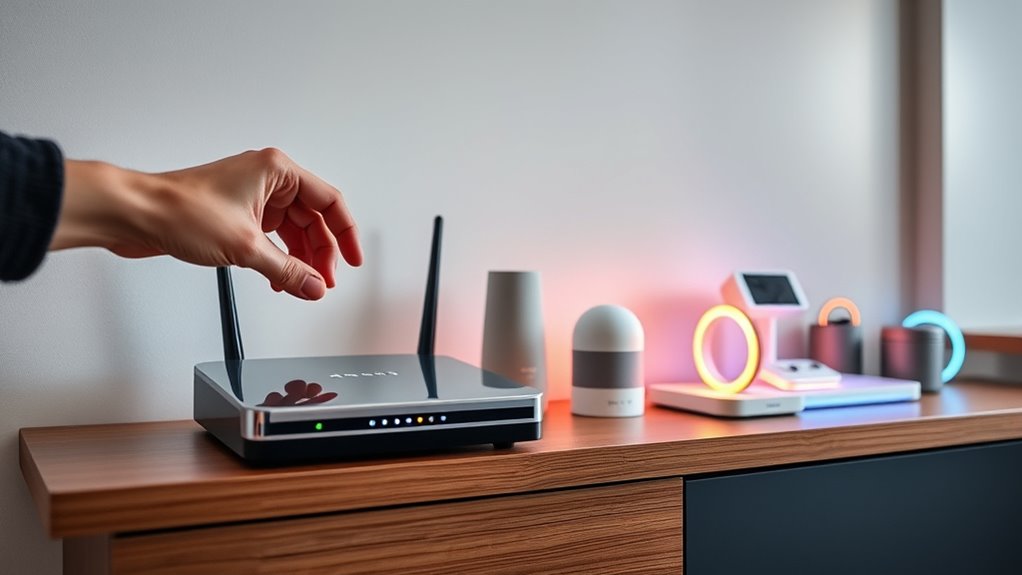
Replacing faulty or outdated Wi-Fi devices is essential for maintaining a stable and efficient network. When your router or Wi-Fi extender becomes unreliable, your smart home devices may experience frequent disconnections or slowdowns.
Upgrading to a high-performance router designed for smart home setups supports more devices simultaneously and reduces network drops. Consider these key points:
- Swap out old or cheap Wi-Fi extenders that cause interference.
- Invest in a router with advanced features like MU-MIMO for better device handling.
- Replace low-capacity hardware that struggles with over 20-30 devices.
- Remove conflicting or faulty hardware to ensure consistent communication.
Understanding wireless technology can help you choose equipment that offers better range and stability for your smart home. Additionally, keeping up with SQA techniques and tools can inform how you troubleshoot and optimize your network performance. Incorporating network security protocols is also vital to safeguard your connected devices from vulnerabilities. Being aware of special occasions such as birthdays and celebrations can help you plan timely upgrades or maintenance to minimize disruption during festive periods. Regularly reviewing your network setup and staying informed about latest advancements ensures your smart home remains reliable and secure.
Implementing Mesh Networks and Wired Backhaul Solutions
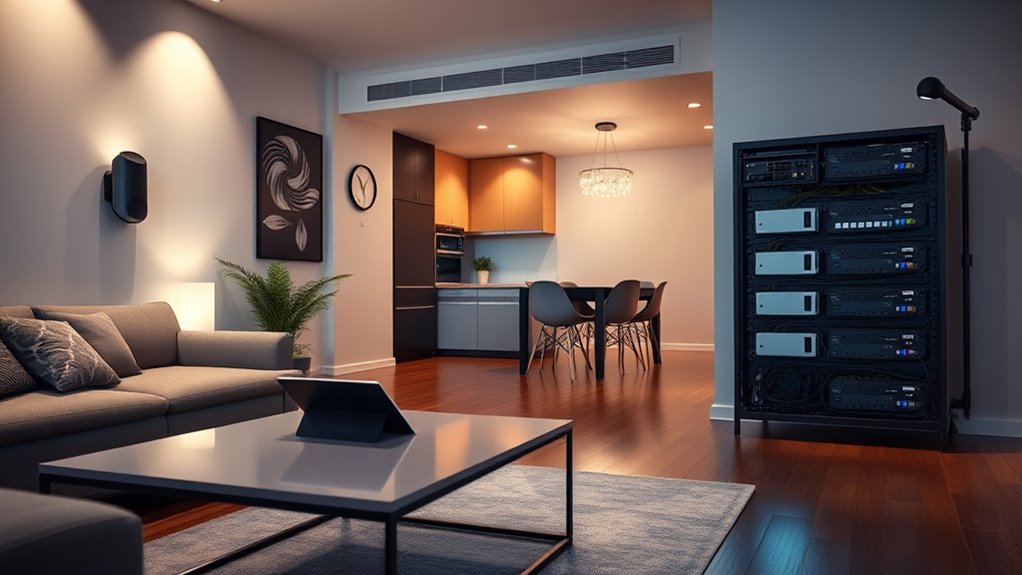
Implementing a mesh network with wired backhaul can greatly improve your apartment’s Wi-Fi coverage and stability. By strategically placing nodes and connecting them with Ethernet cables, you reduce congestion and boost speeds, even with multiple devices. A well-designed setup can also ensure your network remains preppy dog names resilient and adaptable to future smart home expansions.
Mesh Network Benefits
Mesh networks use multiple nodes that work together to provide seamless Wi-Fi coverage and eliminate dead zones in your apartment. This setup guarantees your smart home devices stay connected without interruptions.
Benefits include:
- Improved speed, especially with wired backhaul, which connects nodes via Ethernet for faster, more reliable performance.
- Reduced latency, making your streaming, gaming, and video calls smoother.
- Higher device capacity, supporting over 75 devices simultaneously without slowing down.
- Future-proofing your Wi-Fi with systems like Wi-Fi 7, capable of reaching speeds up to 10 Gbps.
Wired Backhaul Advantages
Wired backhaul substantially boosts your mesh network’s performance by using Ethernet cables to connect nodes directly, rather than relying solely on wireless links. This setup markedly enhances your mesh system’s reliability and speed, providing faster speeds and more stable connections.
With wired backhaul, your network reduces congestion by freeing up Wi-Fi bandwidth, which means your devices can communicate more efficiently. Running Ethernet cables through walls or ceilings allows for a seamless wired backhaul without disrupting your apartment’s layout.
This setup supports higher speeds and handles multiple devices simultaneously, making it ideal for streaming, gaming, and smart home devices. Overall, wired backhaul is essential for maximizing your mesh network’s potential and ensuring a robust, high-performance Wi-Fi experience.
Optimal Placement Strategies
To achieve peak Wi-Fi coverage and performance in your apartment, strategic placement of your mesh nodes is essential. Proper placement guarantees maximum coverage and speeds.
Consider the following:
- Place your primary mesh node in the center of your apartment, elevated and away from obstacles, to maximize coverage.
- Use wired backhaul connections between mesh nodes with Ethernet cables (preferably Cat 6E or higher) for stable, high-speed links.
- Position additional mesh nodes in high-traffic areas or dead zones to eliminate Wi-Fi dropouts.
- Regularly analyze signal strength with tools to fine-tune placement, guaranteeing consistent coverage across all rooms.
These strategies enhance coverage, reduce congestion, and support advanced Wi-Fi standards for your smart home.
Securing Your Network and Managing Device Connections
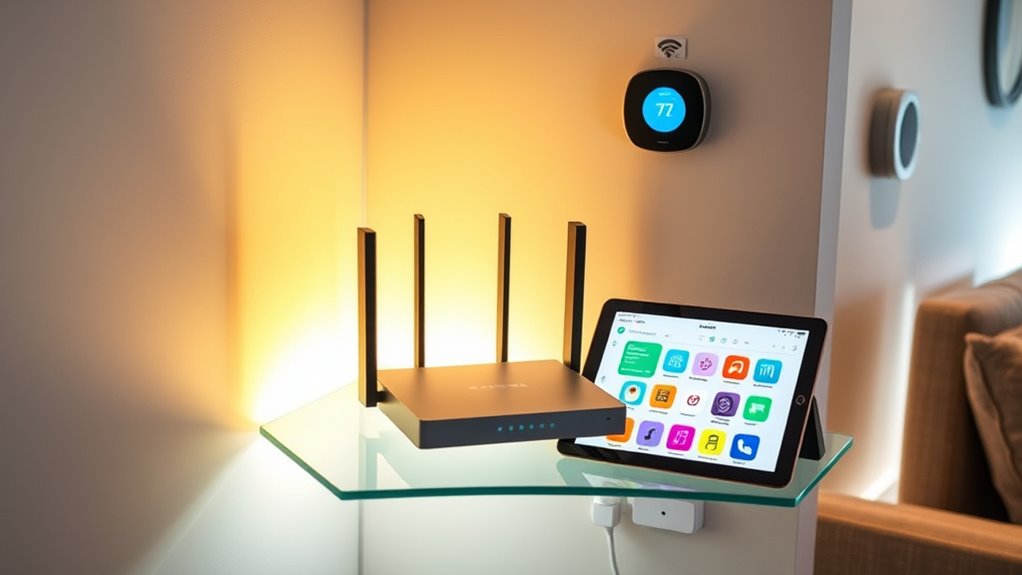
Securing your Wi-Fi network with a strong password is essential to prevent unauthorized access and protect your data. A secure network keeps hackers and intruders out, reducing risks to your connected devices.
Use separate guest networks with distinct passwords to isolate smart home devices from your main network, enhancing security.
Regularly update your router firmware to patch vulnerabilities and boost performance, ensuring your devices stay safe.
Disable features like WPS and remote management to minimize entry points for potential attackers.
Monitoring your connected devices through your router or network management app helps you identify suspicious or unauthorized connections quickly.
Taking these steps strengthens your network security, safeguards your smart home setup, and maintains reliable connectivity for all your devices.
Planning for Future Growth and Smart Home Expansion
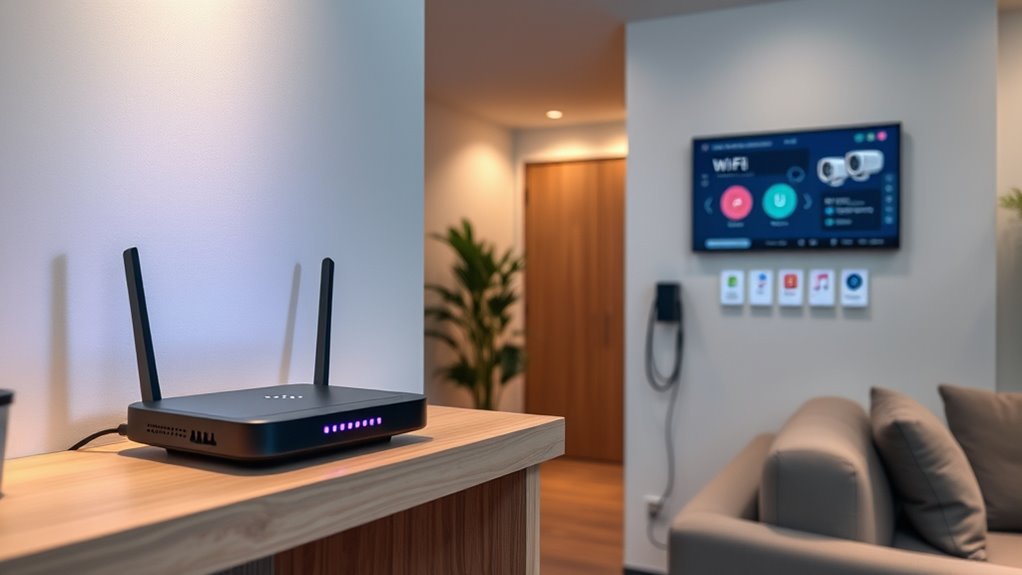
As your smart home grows, planning for future network needs becomes essential to maintain reliable connectivity. To handle future growth and increased device capacity, consider these key steps:
- Choose a Wi-Fi system supporting at least 75-150 devices simultaneously to prevent slowdowns.
- Upgrade to mesh networks with wired backhaul for improved coverage and stability.
- Select routers compatible with Wi-Fi 6E or Wi-Fi 7 to stay ahead of upcoming smart home devices.
- Add access points or mesh nodes now to avoid costly upgrades later.
Regularly review your network’s specifications and user feedback to ensure it can handle future device demands. Proper planning today guarantees your smart home remains efficient and reliable as it expands.
Frequently Asked Questions
Can I Make My Apartment a Smart Home?
Yes, you can turn your apartment into a smart home. You simply need to select compatible devices like smart sensors, cameras, and speakers, then set up a reliable Wi-Fi network.
Upgrading to a mesh system with Wi-Fi 6 or 6E will help handle multiple devices smoothly. Make sure you have permission to install hardware, and position your router or mesh nodes wisely to ensure consistent connectivity and security.
Is It Worth Upgrading to Wifi 7 From Wifi 6?
You wonder if upgrading to Wi-Fi 7 from Wi-Fi 6 is worth it. While Wi-Fi 7 offers faster speeds and better performance in crowded environments, many homes don’t need that extra power yet.
If your devices are compatible and you use bandwidth-heavy applications like VR or 4K streaming, the upgrade makes sense. Otherwise, Wi-Fi 6 remains reliable, and upgrading may not deliver noticeable benefits right now.
How to Improve Wi-Fi Reliability?
To improve your Wi-Fi reliability, start by placing your router in a central, elevated spot to reduce dead zones.
Upgrade to a mesh system with wired backhaul for better coverage.
Replace old routers and extenders with high-quality, compatible gear to minimize disconnections.
Adjust Wi-Fi channels to less crowded frequencies and keep firmware updated.
Securing your network with strong passwords also prevents interference and maintains a stable, reliable connection.
Will a Wi-Fi Booster Work in an Apartment?
Did you know over 60% of apartment Wi-Fi issues are caused by poor coverage?
A Wi-Fi booster can work, but it’s not always the best solution. You need to place it midway between your router and dead zones, and choose a high-quality, dual-band extender supporting MU-MIMO.
Otherwise, it may cause more problems, like disconnections and interference, especially in apartments with thick walls or multiple units.
Conclusion
By balancing bandwidth, boosting coverage, and securing your setup, you’ll build a better, bug-free smart home. Taking thoughtful steps—like testing, tweaking, and upgrading—ensures seamless connectivity and smarter living. Don’t delay your device dreams; dedicate time to design a dependable network today. With a little effort, you’ll enjoy flawless functions, fabulous features, and future-ready freedom—making your apartment a haven of hassle-free harmony. Your smart home’s success starts with your Wi-Fi wisely working!









